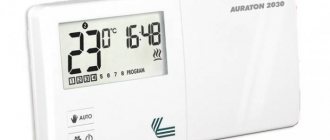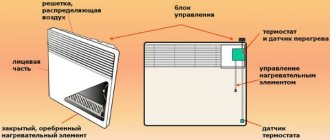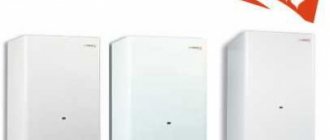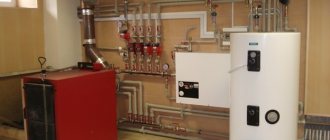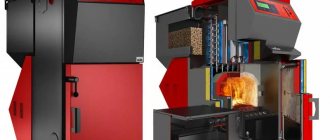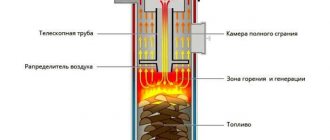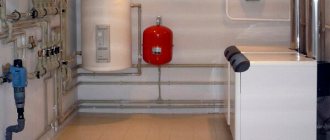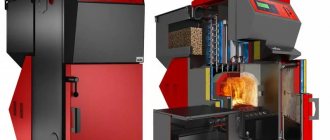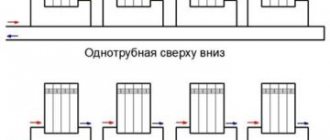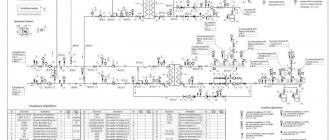Residents of apartments who have decided to abandon central heating, as well as owners of private houses, have plenty to choose from. For autonomous heating, gas and electric systems are used - boilers, heated floors, infrared and oil heaters, convectors. In medium-sized or large-sized rooms, it is advisable to install boilers that run on electricity or gas. Let's look at the first type of heaters, the features of their installation in an apartment, the rules of choice, as well as all the pros and cons that electric boilers have.
How to abandon central heating and switch to individual heating is written here.
Why is an electric heating boiler better than a gas one?
Despite the fact that gas is a cheaper source of energy than electricity, installing gas equipment is not always preferable. The main obstacles to installing a boiler of this type are:
- Difficulties with obtaining permission, coordination and preparation for installation. The room must have a properly organized ventilation system and removal of combustion products.
- High cost of equipment and labor intensive installation. And if we are talking about a private house where gas is not supplied, then the costs increase significantly.
- Potential danger of the fuel itself and its combustion products.
Advantages of electric heating systems
Electric boilers have many advantages, including:
- High reliability in terms of fire safety (of course, subject to the availability of high-quality wiring and fuses).
- Low installation costs, easy installation.
- Wide price range, choice of functions. In general, electric models are cheaper than gas models. You can choose a simple boiler, consisting of a set of heating elements and a primitive control system, which will cost very little. If there are no financial restrictions, you should pay attention to automated devices. They are able to maintain a given temperature with minimal energy consumption and have several programming modes, a GSM controller that allows you to regulate the operation of the device from a distance, and other useful options.
- Compact and aesthetically pleasing. In many modern models, all the necessary elements - a circulation pump, an expansion tank, an air vent, protection systems - are hidden inside the housing. If desired, the electric boiler can be installed in any room of the apartment. The most common are wall-mounted varieties.
- Ease of use. To control the device you only need to press a few buttons. Electric boilers do not require control or participation in their operation.
- Silence. The owners can only hear the quiet hum of the induction device or the hum of the automation units.
- There is no need for coordination with relevant organizations when the device power does not exceed 9 kilowatts.
- High efficiency.
What are electric energy-saving heating boilers?
Why are they needed and how are they used?
If it is possible to connect to a gas main, you should choose a gas boiler without hesitation. Otherwise, electric boilers can be used as the main heating equipment, or as an additional one, for example, in conjunction with solid fuel or liquid fuel. Then the simplest low-power boilers with a thermal power of 3-6 kW are used. This power is enough to temporarily (up to 2-3 days) retain heat in a house with an area of up to 100-120 m2.
This is what the VIN-3 induction electric boiler looks like. A compact dark case with floor mounting instead of the usual wall-mounted rectangle.
The simplest low-power models cost between 11-13 thousand rubles.
As a main one, even the most economical electric boiler can be used in a private house with an area of up to 100 m2. The best and most effective option is temporary heating of a country house when the owners come only on weekends or during vacation.
The cost of electric boilers is extremely low compared to other types, they are easy to install (there is no need for ventilation or a chimney), electric boilers do not require attention or particularly careful maintenance. The cost of electricity consumed during such irregular use will be covered for a long time by the low initial price of the electric boiler. If the heating system is not drained of coolant, it becomes practically autonomous.
Design and principle of operation
Electric boilers, unlike other types, have a fairly simple design. A heating element (heating element, electrodes or induction coil) is placed in a steel body, which heats the coolant according to the flow principle. The coolant can circulate naturally or forcedly (using a circulation pump).
Let's look at the principle of operation and the effect on energy consumption in more detail for each type:
- Heating elements (rheostatic) electric boilers. Modern models use steel heating elements (tubular electric heaters), most often in pairs for greater power and heating speed. New electric heating boilers are more powerful, have the usual square body with a wall mount, which houses other elements of the heating system: a circulation pump, a safety valve and a pressure sensor, automation and a control panel.
Construction of a standard heating element electric boiler.
They are also equipped with the greatest functionality: modulated power, various operating modes, weekly planning, and the ability to connect a room thermostat. However, serious disadvantages of heating electric boilers are the formation of scale and the dependence of their efficiency on the hardness of the water and the thickness of that same scale. They can only be called economical when using extremely pure soft coolant and the additional presence of softening filters. - Ionic (electrode). Electrodes fixed at a certain distance from each other are used as a heating element. Alternating current changes their polarity (50 times per second at a standard frequency of 50 Hz), as a result of which the water ions between them are in constant motion, their temperature rises.
A visual principle of operation of an electrode heating boiler.
Electrode boilers are increasingly in demand and are the most economical; scale does not form on the heating elements, which has a positive effect on their durability and stable efficiency. In addition, such boilers are absolutely safe and do not require intervention even after power outages, since heating of the liquid between the electrodes begins immediately after electricity is supplied to them.Is it worth using electrode boilers for heating a private house?
- Induction (vortex). An induction coil is used as a heating element, the magnetic field of which heats the core located inside it (most often a steel pipe). Thermal energy from the heated core is transferred to the coolant flowing through it. With this heating method, virtually no scale is formed, and the coolant heats up 1.5-2 times faster.
Operating principle of induction electric boilers.
Typically, induction boilers are equipped with modern advanced automation that can provide the most economical heating mode. However, they are not so in demand due to their high cost, comparable to models of wall-mounted gas boilers.
Are induction electric boilers justified in the heating system of a private home?
Disadvantages and difficulties of operating electric boilers
The advantages of electric boilers look attractive. But they also have disadvantages, and very significant ones.
- High cost of electricity.
Note! Costs can be reduced several times by insulating the apartment, using preferential electricity tariffs and choosing a device with precise adjustment.
- Requirements for the type of radiators. In an electrically heated system, it is uneconomical to use cast iron and steel batteries. It is advisable to choose bimetallic or, as a last resort, aluminum heating devices.
- Complete dependence on power supply.
- Demanding on the quality and composition of the coolant.
- When installing equipment that consumes more than 9 kW, instead of a standard 220 V network, a three-phase 380 V network will be required. If the apartment does not have one, you must obtain special permission for the installation, which is not always possible in old houses.
USEFUL INFORMATION: Bosch GSR 1440-LI screwdriver: review and reviews
Before you decide to purchase and install an electric boiler, you need to weigh all the pros and cons, calculate the approximate electricity consumption per month and think about how significant it will be for the budget.
Selection and recommendations
There is a sufficient selection of domestic and foreign equipment on the market, so it is worth deciding in advance on the type and characteristics of the future boiler. Energy-saving electric boilers have several properties that should be taken into account when choosing a heating system.
The choice is determined by the following key characteristics:
- Efficiency . Standard energy-saving boilers have an efficiency level of about 98%, and automatic control contributes to the optimal level of heat production.
- A design that can be easily matched to a specific room interior.
- Functionality . The line includes models with instant heating. This heating of the coolant increases efficiency and simplifies the adjustment of boiler power. Also, each model has its own additional options that help improve the control and operation of the boiler. It is worth considering that the price also depends on the number of additional sets of options - the more there are, the higher the cost of the model.
The small size of the equipment allows you to fit an electric boiler into any room Source ultra-term.ru
- Warranty and service life . When purchasing certified equipment, the client is issued a guarantee, which indicates the period of warranty operation, and also informs about the features of repairing the equipment in the event of a breakdown. You must understand that the warranty period and service life are different concepts. So, if the warranty period is 10 years, this means that the device is guaranteed to work for this period, or it will be repaired for free. And the service life can exceed the warranty and be 20, 30 or more years.
- Manufacturer and brand of boiler . You can choose an energy-saving heating boiler for a private home not only according to preferences, but also according to reviews from real users.
The choice of boiler is made in accordance with the required characteristics. It is worth paying attention to the price segment, since different models with the same set of functions have different prices. Most often this is due to the manufacturer and materials used in the manufacture of the boiler.
A large number of positive reviews confirm the effectiveness of using this type of autonomous heating. Users emphasize the ease of installation of equipment, ease of control and reliability of electric boilers.
Electric boilers with heating elements (tubular heaters)
Such boilers work on the same principle as most household electrical appliances - kettles, boilers, irons. They are most in demand among consumers and are presented in a wide variety of models. There can be several heating elements, and they are turned on together or alternately.
Pros:
- simplicity of design;
- reliability of the circuit, ease of repair.
Minuses:
- high inertia of boilers - slow heating at startup;
- demands on the quality of the coolant. The tendency for scale to form, which reduces heating efficiency, forces special measures to be taken. You can install anode rods that will collect salt deposits on themselves, and change them at certain intervals, just like the heating elements themselves. But it is better to use specially prepared water or a special coolant.
Design and principle of operation of the equipment
Electric boilers have a simpler design compared to their gas counterparts. The heating element is housed in a steel casing. There are 2 pipes - one flows cold liquid, the other is used to remove hot liquid. The system can be filled with prepared water with the required physical and chemical characteristics or antifreeze. On the body of the device there are terminals for connecting to the electrical network.
Models are available that provide single-phase and three-phase power. The device is controlled by an automation unit. Inexpensive units use mechanical adjustment of parameters. The coolant circulates naturally or forcedly using a pump.
In “smart” boilers that provide optimal energy consumption, induction or ion heating blocks are most often used. Such units are economical and demonstrate high reliability.
Heating element installations operate by heating a tungsten or nichrome conductor when current is passed through it. Due to the high resistivity, the temperature of the metal increases. The thermal energy is then transferred to the circulating fluid.
Induction boilers for heating a private house consist of 2 blocks - a control unit and a heating tank. Using control sensors, the user adjusts the operation of the unit. The tank consists of a cylindrical body, inside of which there is a multi-turn inductor and a hollow core made of a ferromagnetic alloy.
When connected to the network, eddy currents are formed around the rod, which heat the metal. Water flows through the core. Heat is transferred to the fluid, which enters the heating circuit. When the temperature reaches the set value, the automation turns off the heating element.
Ionic plants operate by electrolysis of a liquid. An alternating current is passed through the coolant. As a result, charged particles begin to move randomly, causing the liquid to heat up. Such units are made in the form of a cylinder, inside of which a rod is placed.
Voltage is supplied to the housing and electrode. Water flows into the heating unit, reaches the set temperature and enters the heating system.
Induction devices
Induction boilers are energy-efficient and reliable devices that can operate for years without maintenance or repair.
Pros:
- thanks to the phenomenon of self-induction, they significantly save energy (up to 30% during the heating season);
- undemanding to the composition of the coolant (scale does not appear in such boilers);
- service life - from 30 years, the likelihood of breakdown due to the design features is very low;
- quick heating of the coolant;
- possibility of precise adjustment.
Minuses:
- large mass (from 30 kg) - strong brackets are used for hanging, the wall must be able to withstand the load;
- circulation pump, expansion tank, safety group are purchased and installed separately;
- relatively high cost;
- vibration noise during operation.
Installation in an apartment of an apartment building
When installing electrical equipment, it is recommended to adhere to the following rules:
- The negative effect of drafts can be minimized if convectors are installed under the windows.
- For optimal heating, buy an in-floor option.
- The equipment must not be operated without grounding.
- Warm floors are best installed in the kitchen and bathroom.
- To regulate the intensity of work, thermostats are installed.
- Oil heaters are rarely used in city apartments. This option is ideal for a country house.
Ionic (electrode) heating boilers
Such devices heat the coolant by applying voltage through the electrodes, resulting in the ionization of molecules and their movement towards a conductor with a different polarity. In a single-phase network, one electrode is used in the form of a rod, the second is the surface of a metal cylinder, with three-phase voltage - 3 electrodes.
USEFUL INFORMATION: Main types of primer for wall treatment
The sizes of ion boilers vary from very small ones, capable of heating only one battery, to large installations designed for a large house. Available both with and without casing.
Pros:
- compactness. The device without a housing takes up little space;
- high-speed heating of the coolant;
- low inertia, allowing very precise adjustment;
- resistance to voltage surges;
- high level of safety - if there is no coolant in the boiler, it simply cannot work;
- low price (without control unit, pump and expansion tank).
Minuses:
- complete incompatibility with batteries made of steel and cast iron;
- demands on the quality of the circulating fluid, which must have a balanced composition. It is recommended not to make it yourself, but to purchase a ready-made one;
- the need for a specialist to check the condition of the coolant before the new heating season;
- special requirements for the grounding loop;
- heating temperature – no higher than 75 °C;
- the need to replace electrodes at certain intervals.
Rating of the 5 most economical electric boilers for the home 2022
If we talk about domestic producers, we can note two leading models.
- Evan brand boilers are reliable and silent. Thermal elements are heating elements with an automatic control mode installed in the form of a seven-block unit. The heat exchanger has a unique design and is made of a single seamless piece, which ensures complete absence of leaks. The thermal circuit is equipped with a pump for circulating coolant and an expansion tank. The safety of the EC operation is ensured by a multi-level system equipped with a microprocessor unit. A 5 kW device costs approximately 30 thousand rubles.
- Another domestic and inexpensive boiler from the Galan company has a 3-level power, is capable of operating from both a regular and a three-phase power supply, is compact and light in weight. The boiler is very economical, consuming two times less kilowatts than a heating element boiler of similar power. Operating efficiency is ensured by a smooth start from modern automation.
- Geyser is considered the leader of electrode boilers in the range from 9 to 15 kW, the price indicator ranges from 3.5 to 15 thousand rubles. The plant produces a similar heating boiler “Ochag”, but slightly less powerful than the “Geyser”, as well as the “Vulcan” boiler, the latter the most powerful and can produce 50 kW of heat. One of the conditions for the operation of such EC is the technological impossibility of emergency replacement of electrodes at home; this type of work will require specialists.
- Standard Galan ECs weigh only 3 kg and have a thermal power of 3-25 kW. Manufacturers have equipped the device with a coolant temperature regulator up to 90C with the ability to heat up to 90 m2 of area.
- The Polish boiler KOSPEL EKCO also occupies a leading position among the top boilers for homes with electricity, has an almost maximum efficiency of 99% and is used for heating with radiator heating appliances, and can also be included in a circuit with a water heater for hot water supply needs. Models with a power above 50 kW operate from three-phase networks, there are two control modes - manual and automatic. The software monitors the maintenance of the coolant temperature to ensure a sanitary air temperature in living rooms. The disadvantage of this heater, as with all heating element-type boilers, is the high requirement for feed water, due to scale formation processes in the heating medium. Despite the fact that the manufacturer bothered and equipped them with filters for water purification, sometimes this is not enough to properly prepare the water. Boilers are sold in a price range depending on power from 15 thousand rubles. up to 30 thousand rubles
- Rusnit 209M is a small energy-efficient boiler with a power of 9 kW, capable of heating an area of 90 m2. The good layout of the EC ensures easy installation, the boiler is fully automated with an accuracy of 0.5 C and has protection against water overheating. Operating experience suggests that the boiler has been operating without failures for several years.
Single-circuit and double-circuit boilers: what is the difference?
Let's look at the differences between the two modifications of these units.
- Single-circuit boilers are designed only for heating the room. At the same time, an indirect heating boiler can be connected to all modern boilers and hot water supply can be provided.
- Double-circuit, in addition to participating in the heating system, heat water for domestic needs. Their design provides an additional heat exchanger, which can be flow-through or storage - in the form of a built-in water heating tank.
Note! A double-circuit boiler cannot operate on 2 circuits at the same time. When you open a hot water tap, heating of the heating fluid stops.
Let us briefly describe their advantages and disadvantages.
Advantages of a single-circuit boiler:
- relatively low cost;
- high efficiency and high power;
- lower energy consumption (no boiler).
Minuses:
- if necessary, you will have to install an additional boiler to heat water;
- together with an indirect heating boiler, the design looks bulky and unaesthetic.
Advantages of a dual-circuit device:
- quite compact size;
- easy installation.
Minuses:
- instability of water pressure and temperature;
- high requirements for coolant quality and maintenance;
- high cost.
Note! If we compare the prices of a double-circuit boiler and a device with one circuit and an additional boiler, the first will cost less.
It's difficult to say which boiler is better. If it is important to save energy, as well as space in the apartment, you should choose a double-circuit version. This device heats water only when it is needed; the single-circuit device will turn on every time the liquid cools down. At the same time, a single-circuit boiler is considered more reliable and convenient to use.
Advice. If your automated boiler has an additional storage tank, it can be programmed to heat water at night when electricity rates are lower. During the day, when the cost of electricity is higher, you can use already heated water.
How to choose an electric boiler for heating a private house
Single-circuit or double-circuit
Single-circuit electric boilers heat the coolant in one circuit - the heating circuit. Double-circuit ones are designed for both heating and hot water supply (DHW). In this case, sanitary water from the DHW circuit does not mix with technical water from the heating circuit.
Double-circuit electric boilers cost only 10-30% more than their single-circuit counterparts and are the most cost-effective way to organize hot water supply at home. However, they are popular only with owners with a relatively unlimited budget, since expensive electricity is also spent on preparing sanitary water.
Single-phase or three-phase power supply
Low-power models up to 6 kW inclusive operate from a standard single-phase network (220-230 V). More and more powerful models require the organization of a three-phase electrical network; this should be taken into account before purchasing an electric boiler. Otherwise, the power of a single-phase network will simply not be enough, the boiler will not be able to provide maximum heating output, the water will take longer to heat up to the set temperature, and in severe frosts the heating output may not be enough at all.
Additionally, information about electrical requirements is always indicated in the technical specifications of the model.
Automation functionality
The most inexpensive models of electric boilers operate on the “On/Off” principle. We recommend choosing electric boilers with at least 3-stage power control, and better yet, with degree-by-degree temperature control. Even greater efficiency can be achieved by electric boilers with a built-in programmer, which allows you to set operating parameters for the next day or week. This way you can set the temperature to 15°C during working hours when the owners are not at home. Also set the temperature to 18-19°C during sleep or, conversely, heat the house more actively at the night electricity tariff if a multi-tariff meter is installed.
However, the built-in programmer is not present in all even expensive models. But almost all modern electric boilers allow you to connect external control, for example, a room thermostat - the most economical and comfortable option of all existing ones. A technologically advanced electronic room thermostat with programmability allows you not only to implement what was described earlier, but also to make more accurate measurements, focusing on the air temperature in the room, and not the temperature of the coolant.
How to choose an external thermostat for an electric boiler and save up to 30% on heating every month
Also in modern models it is possible to support weather control, when the automation adjusts the operation of the boiler to external weather conditions. If the boiler is planned to be installed in a temporary home, frost protection is mandatory to prevent icing and damage to the heating system lines. However, we do not recommend overdoing it with options that are not useful; it is better to find a middle ground. The minimum functionality required for comfort and efficiency is degree-by-degree temperature control, the ability to connect external control or a built-in programmer.
Minimum required power
In practice, the required power is usually calculated in a simplified form, based on the rule: for an average house in the Moscow region with 2 bricks and a ceiling height of up to 2.7 m, 1 kW of heating equipment power is required for every 10 m2 of area. We also recommend setting aside a 15-20% power reserve; for heating electric boilers - up to 30% reserve (more on this later). If the boiler is double-circuit, we recommend adding another 10% power reserve on top.
For example, for a house with an area of 120 m2, the minimum required power of a heating element single-circuit electric boiler is 120/10 * 1.3 = 15.6 = 16 kW.
This method is sufficient in more than 95% of cases. If the house is well insulated, is located in the extreme southern or, conversely, in the extreme northern point of the country, has high ceilings and a large glazing area, it is necessary to make a more accurate calculation taking into account correction factors. You can make a more accurate calculation using the calculator below (for each room separately, then summed up), or better yet, by involving a heating engineer.
Power
The power of the boiler is its most important characteristic, which means you need to choose it correctly. Sometimes it is tied to the footage and calculated based on the value of 1 kW per 10 m2. This formula is only suitable for a very rough estimate.
USEFUL INFORMATION: How to choose wallpaper for the living room: interior design
In fact, you need to focus on heat loss. If, for example, they are 8 kW, then you need a boiler of the same power. The calculations take into account:
- area and height of the room;
- degree of insulation of walls, floors, ceilings;
- the number of external walls and their location according to the cardinal directions;
- number, dimensions and type of windows;
- battery connection diagram;
- region of residence and other parameters.
To correctly calculate the boiler power, it is recommended to use special calculators or seek advice from a heating engineer.
How to save on electricity in an apartment?
Thermostats help to significantly save energy consumption. Thanks to them, it is possible to determine the optimal temperature regime and not overuse the resource. Additionally, it is also recommended to use a multi-tariff meter. With its help it will be possible to reduce consumption at night. Heat can escape through walls or windows. That is why they should be carefully insulated. Proper thermal insulation can save up to 40%.
Additional functions
The following functions of electric boilers may be useful:
- protection systems – from overheating, short circuit, overpressure;
- the ability to install a GSM controller, which will allow you to remotely adjust the temperature in the apartment, change the boiler settings, and send notifications about possible problems;
- a control unit with energy-saving modes that allow you to reduce the temperature at certain periods of time - at night, when residents are not at home;
- smooth power adjustment. This option is more convenient and profitable than the stepped one.
Note! Often control units are not included in the package of electric boilers. In this case, they will have to be purchased separately.
Reviews of household electric boilers: advantages and disadvantages
| Advantages | Flaws |
| Easy to install and connect. You can install an electric boiler without any special skills; moreover, it does not require a chimney, ventilation system, or boiler room. From the piping - only the supply and return lines (and the DHW circuit in dual-circuit models). | The highest operating costs among all types of boilers. According to operating practice and reviews from owners, even the most energy-saving models and proper use of a room thermostat will not reduce costs to the cost of heating with gas, wood or liquid fuel. |
| Compact sizes. Heating element models have smaller dimensions than gas and liquid fuel wall-mounted counterparts. Compact electric boilers in the form of a flask with a heating element or ionic models barely exceed the diameter of the heating system line. | Models with power over 6 kW require connection to a more powerful three-phase power supply (380 V). Electrical equipment with a power of more than 10 kW requires approval from local Energy Supervision services. |
| Autonomy and convenience. Electric boilers are almost ideal in this regard, since they can work for weeks and months without human intervention. Almost all models have the ability to connect external thermostats. | When using an electric boiler as the main heating equipment, the heating system becomes completely dependent on the power supply. If there are any interruptions, the house may be left without heat. |
| Safety and environmental friendliness. Electric boilers do not produce emissions, there is no open fire, and all models have overheating protection. | Powerful electric boilers create a significant load on the electrical network of the house. Therefore, they require high-quality and serviceable wiring. |
| Low cost of equipment and its installation. | |
| Almost silent operation. | |
| Availability of both single-circuit and double-circuit models. | |
| Low maintenance requirement, simple and reliable device, in which many components have an almost unlimited resource. |
Popular models
Among the variety of brands, the leading positions in the ranking are occupied by the following manufacturers:
- Protherm (Slovakia),
- Vaillant (Germany),
- Kospel (Poland),
- Buderus (Germany).
Among Russian brands, buyers give preference to 4 brands, including:
- "TEPLODAR"
- "EVAN"
- ZOTA,
- "RusNIT".
The best models from the category of medium-power boilers that are suitable for apartments, based on user reviews:
- Teplodar Sputnik 6 (8.1 thousand rubles);
- RusNit 208M (average price - 16 thousand rubles);
- EVAN Warmos-IV-5 (16.5 thousand rubles);
- ZOTA 12 Lux (RUB 21.4 thousand);
- Kospel EKCO L2 12 (37 thousand rubles);
- Protherm Skat 12 KR 13 (32.5 thousand rubles);
- Vaillant eloBLOCK VE 12 (35 thousand rubles);
- Buderus Logamax E213-10 (9.3 thousand rubles).
Teplodar Sputnik 6 in black
Teplodar Sputnik 6 in white
Heating electric boilers - the traditional choice
The production technology of devices of this type has gone through several stages of improvement. They are as convenient as possible, inexpensive and will last for a long period of time. The heating element unit is characterized by the following advantages:
- The heating coil quickly releases heat.
- The heating element can be replaced separately if it fails.
- High degree of reliability and minimal risk of emergency situations.
The building can be heated within 15 minutes after starting the electric boiler.
Types of heaters for heating systems
Despite the market diversity, water heating units, depending on what raw material is fuel, are divided into the following types:
- Gas. This is the most common type due to its efficiency and relative cheapness of fuel.
- Solid fuel. These water heating boilers are common in rural areas and areas remote from gas mains.
- Liquid fuel. They are the least popular because they are complex and expensive to operate.
- Electrical. Popular among urban users. They are distinguished by their efficiency, but also by the high cost of fuel - electricity.
- Combined. This is a universal type of heater that helps control fuel costs depending on market conditions.
According to their purpose, water heaters are divided into the following:
- Single-circuit, providing exclusively heating.
- Double-circuit, which additionally provide hot water for personal needs.
According to the method and location of installation, they are divided into wall-mounted and floor-mounted. Some are produced exclusively in a floor-standing version, for example, running on liquid and solid fuel.
Heating boilers Buderus
Each variety has different characteristics that will have to be taken into account when installing autonomous heating.
Which electric boiler is the most economical? Needed for a house of 60 sq/m.
I guess I don't understand something. It makes sense to talk about efficiency for a gas or solid fuel boiler (where some of the heat escapes into the chimney). and with an electric boiler - for any one, everything that it consumed became heat. Even if it is with a circulation pump, ultimately the kinetic energy of the water is converted into thermal energy, which is released inside the heating circuit. So any electric boiler has an efficiency of 100%. It is selected only according to the power required to compensate for heat loss and the type of heating system (pressure, gravity). To calculate heat loss, there is not enough area - you need the thermal characteristics of walls, windows, doors, climatic characteristics of the area and the orientation of the building. I can say offhand that for heating a standard dacha built in the 30s with an area of approx. 60 sq. m. 20 kW is not enough (Zhukovsky boiler 23.5 kW in severe frosts barely supports the system from defrosting).
satalgat wrote about the air conditioner, apparently he meant a heat pump. The thing is really economical, but insanely expensive, including in operation. Making high-quality insulation is much cheaper.
******
Artificial Intelligence (135226) 5 years ago
The best way to heat up using electricity is with air conditioning.
No comments yet!
Installation nuances
Having selected the equipment, you can begin its installation.
Basic Rules:
- all installation and connection work must be carried out by a service center specialist;
- you need to be sure that the wall on which the device is hung will support its weight;
- There must be free space around the boiler for maintenance.
As a rule, the recommended distance from the side walls of the boiler to the furniture is indicated in the device instructions. The material of the wall to which the unit is attached must not be flammable. The device should hang evenly, without distortions.
The installation procedure is as follows:
- First, the mounts are mounted on the wall. The device is installed on them.
- Grounding work is being carried out.
- The boiler is connected to the heating system.
- Commissioning works are being carried out. The leaks are checked, excess air is bled off, and the system is tested in different temperature conditions.
Experts recommend contacting certified companies for connection. The warranty on many devices may be voided if installed improperly. Induction heating boilers you will find the answer in the link.
Is it possible to install an electric boiler with your own hands?
If you are a skilled person, have the necessary tools and know how to use them, and can choose and buy the necessary materials correctly, then you are in the cards. But at the same time, having chosen a boiler and purchased it, get instructions from the seller for its correct installation and installation, and especially inquire about or receive a boiler connection diagram. If something is not clear to you, ask in more detail and then do everything yourself.
And in the case when you have “hook hands”, a hammer hits your fingers, you drilled through a kitchen table with a drill, or burned through the polish on a coffee table with a soldering iron, then... in this case, invite specialists from a serious store or find them on the Internet. They will do the installation and assembly at the highest level, and will even clean up after themselves.
You will be interested in this article - How to choose a gas heating boiler?
Types of boilers by installation method
Depending on the installation method, the devices can be floor-mounted or wall-mounted. Each type has its own characteristics.
Floor-standing
Floor-standing systems produce more power than wall-mounted ones. Such boilers are designed for heating large cubic capacity. Therefore, they require a separate room for installation. The boiler room can be installed in the basement. In addition, the floor-standing model can be double-circuit, that is, in addition to heating, it can heat water for domestic and household needs, and work as a boiler. The electricity consumption of such a device is higher.
Wall mounted
Wall-mounted boilers are more compact and can be hung in the bathroom or kitchen. They look quite decent and also consume much less electricity than floor-standing ones. Suitable for small houses. Such a unit will be single-circuit, producing either heat or hot water.
Approximate power consumption
Is it worth using an electric boiler for heating at all, or is it better to purchase a more economical type of equipment?
The fact that the efficiency of such devices is close to unity does not mean a profitable solution to the heating problem. The price of electricity is quite high, and your boiler will “eat” it all season long. First, make an approximate calculation for your home according to this scheme:
1. Required performance in kilowatts - the area of heated premises divided by 10.
2. The amount of heat is the power obtained in step 1, multiplied by the total operating time of the device per day. Here you already need to know whether heating a private house with an electric boiler will be the “main” or backup. For the first option, you can take 12 hours as a minimum; in the case of a combined system, subtract the operating time of the main equipment.
3. It is more convenient to immediately convert the daily value into monthly figures - multiply by 30. To reach the annual figure - by another 7 (this is how long the cold season usually lasts).
Having calculated the energy consumption in this way, do not rush to get scared - the result still needs to be divided by 2 in order to bring it closer to the actual operating mode of the heating system. At maximum power it can be used for 2-3 months at most. The rest of the time, the temperature outside the window is not -20, which means that energy consumption will be regulated downwards.
Positive features of EPO-9.45/220V
Economical electric boilers have many advantages over more powerful equipment. For example, they are easy to use, because they have a control panel. This makes using the device safe and easy. The boiler body is durable, because at the factory it is coated with a composition that eliminates the formation of corrosion and ensures the protection of components, as well as the long service life of the unit itself. Such economical electric boilers can be used without incurring additional expenses. After all, you don’t have to clean the chimney, or unload and load fuel.
Installation and maintenance are not accompanied by difficulties: there is no need to install a chimney, as well as a coal bunker and a fuel tank. During operation, the device is silent and environmentally friendly. Its operation does not depend on external factors, and operation will be carried out on an automatic basis. There is no need for constant monitoring, just like in the boiler room.
Smart home heating system
The concept of a “smart” home (smart house, or Intellhouse) is becoming increasingly widespread in the world. In a general sense, a “smart” home is a unified system of heating, lighting, ventilation, alarm, as well as monitoring and automatic control of all engineering systems. This includes smart plugs, thermostats, security cameras, locking mechanisms, and turning consumer electronics on and off. “Comfort management” in such a house is given a central place.
Autonomous and decentralized heating is still most typical for private houses. Well-designed buildings not only symbolize the owner’s commitment to high technology, but also contribute to very real savings. Experts from MiDart, for example, point to a reduction in operating costs by 30%, and in heating costs by 50%. What “features” of smart boilers are used to achieve such savings?

